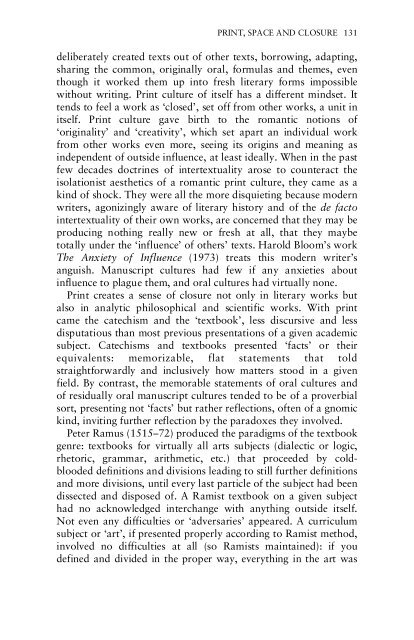Orality and Literacy: The Technologizing of the Word - Monoskop
Orality and Literacy: The Technologizing of the Word - Monoskop
Orality and Literacy: The Technologizing of the Word - Monoskop
Create successful ePaper yourself
Turn your PDF publications into a flip-book with our unique Google optimized e-Paper software.
PRINT, SPACE AND CLOSURE 131<br />
deliberately created texts out <strong>of</strong> o<strong>the</strong>r texts, borrowing, adapting,<br />
sharing <strong>the</strong> common, originally oral, formulas <strong>and</strong> <strong>the</strong>mes, even<br />
though it worked <strong>the</strong>m up into fresh literary forms impossible<br />
without writing. Print culture <strong>of</strong> itself has a different mindset. It<br />
tends to feel a work as ‘closed’, set <strong>of</strong>f from o<strong>the</strong>r works, a unit in<br />
itself. Print culture gave birth to <strong>the</strong> romantic notions <strong>of</strong><br />
‘originality’ <strong>and</strong> ‘creativity’, which set apart an individual work<br />
from o<strong>the</strong>r works even more, seeing its origins <strong>and</strong> meaning as<br />
independent <strong>of</strong> outside influence, at least ideally. When in <strong>the</strong> past<br />
few decades doctrines <strong>of</strong> intertextuality arose to counteract <strong>the</strong><br />
isolationist aes<strong>the</strong>tics <strong>of</strong> a romantic print culture, <strong>the</strong>y came as a<br />
kind <strong>of</strong> shock. <strong>The</strong>y were all <strong>the</strong> more disquieting because modern<br />
writers, agonizingly aware <strong>of</strong> literary history <strong>and</strong> <strong>of</strong> <strong>the</strong> de facto<br />
intertextuality <strong>of</strong> <strong>the</strong>ir own works, are concerned that <strong>the</strong>y may be<br />
producing nothing really new or fresh at all, that <strong>the</strong>y maybe<br />
totally under <strong>the</strong> ‘influence’ <strong>of</strong> o<strong>the</strong>rs’ texts. Harold Bloom’s work<br />
<strong>The</strong> Anxiety <strong>of</strong> Influence (1973) treats this modern writer’s<br />
anguish. Manuscript cultures had few if any anxieties about<br />
influence to plague <strong>the</strong>m, <strong>and</strong> oral cultures had virtually none.<br />
Print creates a sense <strong>of</strong> closure not only in literary works but<br />
also in analytic philosophical <strong>and</strong> scientific works. With print<br />
came <strong>the</strong> catechism <strong>and</strong> <strong>the</strong> ‘textbook’, less discursive <strong>and</strong> less<br />
disputatious than most previous presentations <strong>of</strong> a given academic<br />
subject. Catechisms <strong>and</strong> textbooks presented ‘facts’ or <strong>the</strong>ir<br />
equivalents: memorizable, flat statements that told<br />
straightforwardly <strong>and</strong> inclusively how matters stood in a given<br />
field. By contrast, <strong>the</strong> memorable statements <strong>of</strong> oral cultures <strong>and</strong><br />
<strong>of</strong> residually oral manuscript cultures tended to be <strong>of</strong> a proverbial<br />
sort, presenting not ‘facts’ but ra<strong>the</strong>r reflections, <strong>of</strong>ten <strong>of</strong> a gnomic<br />
kind, inviting fur<strong>the</strong>r reflection by <strong>the</strong> paradoxes <strong>the</strong>y involved.<br />
Peter Ramus (1515–72) produced <strong>the</strong> paradigms <strong>of</strong> <strong>the</strong> textbook<br />
genre: textbooks for virtually all arts subjects (dialectic or logic,<br />
rhetoric, grammar, arithmetic, etc.) that proceeded by coldblooded<br />
definitions <strong>and</strong> divisions leading to still fur<strong>the</strong>r definitions<br />
<strong>and</strong> more divisions, until every last particle <strong>of</strong> <strong>the</strong> subject had been<br />
dissected <strong>and</strong> disposed <strong>of</strong>. A Ramist textbook on a given subject<br />
had no acknowledged interchange with anything outside itself.<br />
Not even any difficulties or ‘adversaries’ appeared. A curriculum<br />
subject or ‘art’, if presented properly according to Ramist method,<br />
involved no difficulties at all (so Ramists maintained): if you<br />
defined <strong>and</strong> divided in <strong>the</strong> proper way, everything in <strong>the</strong> art was

















